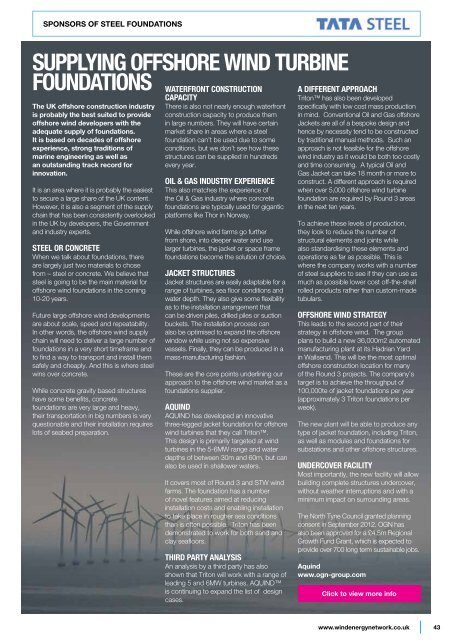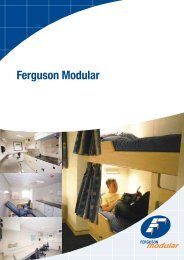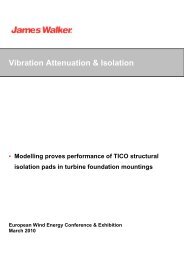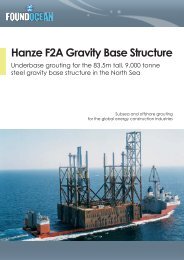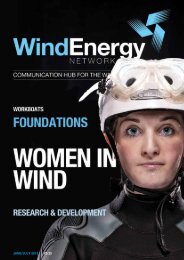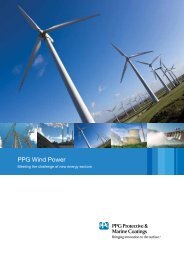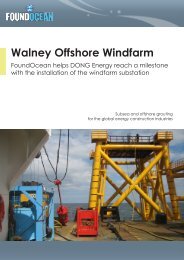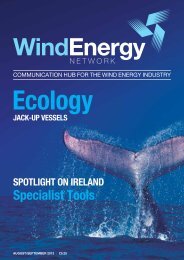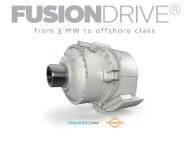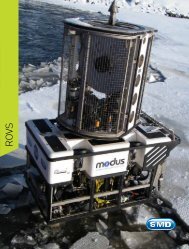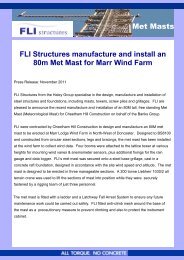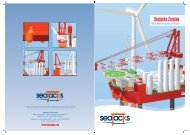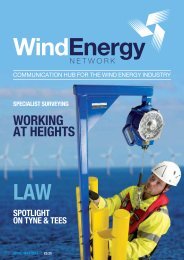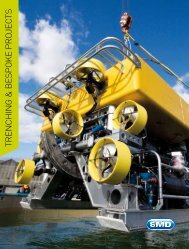UNEXPLODED ORDNANCE - Wind Energy Network
UNEXPLODED ORDNANCE - Wind Energy Network
UNEXPLODED ORDNANCE - Wind Energy Network
Create successful ePaper yourself
Turn your PDF publications into a flip-book with our unique Google optimized e-Paper software.
SPONSORS OF STEEL FOUNDATIONS<br />
Supplying offshore wind turbine<br />
foundations<br />
The UK offshore construction industry<br />
is probably the best suited to provide<br />
offshore wind developers with the<br />
adequate supply of foundations.<br />
It is based on decades of offshore<br />
experience, strong traditions of<br />
marine engineering as well as<br />
an outstanding track record for<br />
innovation.<br />
It is an area where it is probably the easiest<br />
to secure a large share of the UK content.<br />
However, it is also a segment of the supply<br />
chain that has been consistently overlooked<br />
in the UK by developers, the Government<br />
and industry experts.<br />
Steel or concrete<br />
When we talk about foundations, there<br />
are largely just two materials to chose<br />
from – steel or concrete. We believe that<br />
steel is going to be the main material for<br />
offshore wind foundations in the coming<br />
10-20 years.<br />
Future large offshore wind developments<br />
are about scale, speed and repeatability.<br />
In other words, the offshore wind supply<br />
chain will need to deliver a large number of<br />
foundations in a very short timeframe and<br />
to find a way to transport and install them<br />
safely and cheaply. And this is where steel<br />
wins over concrete.<br />
While concrete gravity based structures<br />
have some benefits, concrete<br />
foundations are very large and heavy,<br />
their transportation in big numbers is very<br />
questionable and their installation requires<br />
lots of seabed preparation.<br />
Waterfront construction<br />
capacity<br />
There is also not nearly enough waterfront<br />
construction capacity to produce them<br />
in large numbers. They will have certain<br />
market share in areas where a steel<br />
foundation can’t be used due to some<br />
conditions, but we don’t see how these<br />
structures can be supplied in hundreds<br />
every year.<br />
Oil & Gas industry experience<br />
This also matches the experience of<br />
the Oil & Gas industry where concrete<br />
foundations are typically used for gigantic<br />
platforms like Thor in Norway.<br />
While offshore wind farms go further<br />
from shore, into deeper water and use<br />
larger turbines, the jacket or space frame<br />
foundations become the solution of choice.<br />
Jacket structures<br />
Jacket structures are easily adaptable for a<br />
range of turbines, sea floor conditions and<br />
water depth. They also give some flexibility<br />
as to the installation arrangement that<br />
can be driven piles, drilled piles or suction<br />
buckets. The installation process can<br />
also be optimised to expand the offshore<br />
window while using not so expensive<br />
vessels. Finally, they can be produced in a<br />
mass-manufacturing fashion.<br />
These are the core points underlining our<br />
approach to the offshore wind market as a<br />
foundations supplier.<br />
AQUIND<br />
AQUIND has developed an innovative<br />
three-legged jacket foundation for offshore<br />
wind turbines that they call Triton.<br />
This design is primarily targeted at wind<br />
turbines in the 5-6MW range and water<br />
depths of between 30m and 60m, but can<br />
also be used in shallower waters.<br />
It covers most of Round 3 and STW wind<br />
farms. The foundation has a number<br />
of novel features aimed at reducing<br />
installation costs and enabling installation<br />
to take place in rougher sea conditions<br />
than is often possible. Triton has been<br />
demonstrated to work for both sand and<br />
clay seafloors.<br />
Third party analysis<br />
An analysis by a third party has also<br />
shown that Triton will work with a range of<br />
leading 5 and 6MW turbines. AQUIND<br />
is continuing to expand the list of design<br />
cases.<br />
A different approach<br />
Triton has also been developed<br />
specifically with low cost mass production<br />
in mind. Conventional Oil and Gas offshore<br />
Jackets are all of a bespoke design and<br />
hence by necessity tend to be constructed<br />
by traditional manual methods. Such an<br />
approach is not feasible for the offshore<br />
wind industry as it would be both too costly<br />
and time consuming. A typical Oil and<br />
Gas Jacket can take 18 month or more to<br />
construct. A different approach is required<br />
when over 5,000 offshore wind turbine<br />
foundation are required by Round 3 areas<br />
in the next ten years.<br />
To achieve these levels of production,<br />
they look to reduce the number of<br />
structural elements and joints while<br />
also standardising these elements and<br />
operations as far as possible. This is<br />
where the company works with a number<br />
of steel suppliers to see if they can use as<br />
much as possible lower cost off-the-shelf<br />
rolled products rather than custom-made<br />
tubulars.<br />
Offshore wind strategy<br />
This leads to the second part of their<br />
strategy in offshore wind. The group<br />
plans to build a new 36,000m2 automated<br />
manufacturing plant at its Hadrian Yard<br />
in Wallsend. This will be the most optimal<br />
offshore construction location for many<br />
of the Round 3 projects. The company’s<br />
target is to achieve the throughput of<br />
100,000te of jacket foundations per year<br />
(approximately 3 Triton foundations per<br />
week).<br />
The new plant will be able to produce any<br />
type of jacket foundation, including Triton,<br />
as well as modules and foundations for<br />
substations and other offshore structures.<br />
Undercover facility<br />
Most importantly, the new facility will allow<br />
building complete structures undercover,<br />
without weather interruptions and with a<br />
minimum impact on surrounding areas.<br />
The North Tyne Council granted planning<br />
consent in September 2012. OGN has<br />
also been approved for a £4.5m Regional<br />
Growth Fund Grant, which is expected to<br />
provide over 700 long term sustainable jobs.<br />
Aquind<br />
www.ogn-group.com<br />
Click to view more info<br />
www.windenergynetwork.co.uk<br />
43


